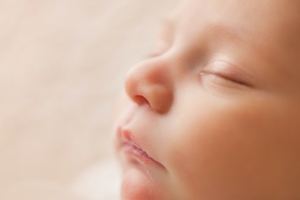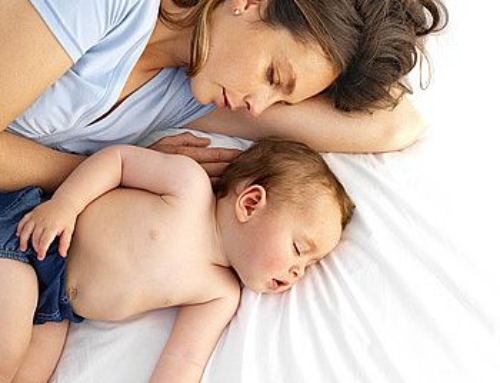
One of the ongoing debates in parenting in our Western culture is the issue of bedsharing. For many who have been raised in this culture, the idea of bedsharing is not only dangerous, but will stymie the development of independence that we believe it is our jobs to instill in our kids. Obviously this belief is cultural and is not a universal, despite many people believing it to be. Many Asian cultures focus instead on the development of interdependence in which the child is believed to have to be brought into the fold of the community and family. As such, something like bedsharing is actually the norm when it comes to sleep.
As bedsharing has increased in Western culture and support for it comes from those involved in research – thanks in large part to researchers like Drs. James McKenna and Helen Ball – more emphasis is being placed on trying to study the effects through a scientific paradigm. In as much as researchers can move away from their cultural bias in research, the recent findings have led to the acknowledgement that bedsharing is not as dangerous as previously believed, with a greater focus needing to be placed on sleep context, not just specific locations[i].
However, one area that continues to be a source of concern for parents is the perceived lack of independence that will follow from bedsharing. Families fear that they will have a child that lacks the ability to self-soothe or comfort and will – as is often put – be sleeping with their parents when they go to college. Understanding the nature of how this develops is essential to seeing how different sleeping arrangements may or may not facilitate the type of emotional development parents expect.
As I have covered elsewhere[ii], the development of self-soothing actually begins with – and requires – co-regulation in which a caregiver meets the regulatory needs of the infant or toddler and this enables them to learn these skills to utilize themselves. Western belief is that this co-regulation is not necessary, but research on how the proximity of infant and mother affects the regulation of physiological properties such as core body temperature and cortisol levels has found closer proximity leads to better regulation[iii][iv][v][vi]. However, the issue of actual calming behaviours at a physiological level had yet to be studied… until now.
Addressing a gap in the literature, researchers aimed to assess the effects of typical sleeping arrangements and deviations from these arrangements on the physiological arousal of infants during sleep[vii]. It is worth noting now that the study was preliminary in that it involved a very small sample size to make comparisons and I’ll discuss what this means for the results.
The Study
The study involved 24 mother-infant dyads where the infants were between 1 and 3 months of age. The families were all from Singapore and of a relatively high SES. All infants were born at term and healthy.
Dyads were grouped according to their typical sleeping arrangements which were ascertained via questionnaire. Groups included regular co-sleepers (which was bedsharing or within arm’s length, n=9), BAL sleepers (room-sharing but beyond arm’s length, n=9), and solidary sleepers (in their own room in a crib, n=6). All groups made these location choices intentionally; that is, they were not reactive to situations that had happened in the short time they had their child.
Calming (or self-regulation) was assessed using Heart Rate Variability (HRV) and Inter-Beat-Interval (IBI). Each of these has been found to be associated with calming, specifically a longer IBI and greater HRV are associated with calming while shorter and lower levels, respectively, are associated with activation of the sympathetic nervous system. These measures were taken during one 30-min nap that included all three sleeping conditions and the order was counterbalanced. This provides within subject data which helps to make up for the lower sample size. The rotation was in 5-min intervals repeated twice. As not all infants stayed asleep (as they don’t always sleep on cue), data was only available for 6 co-sleeping infants, 6 BAL infants, and 5 solitary sleep infants.
The Findings
Because of the design the findings are a bit complicated, so I’m breaking it down bit by bit:
- On average, the co-sleepers (i.e., typical co-sleeping infants) had the longest IBI across all conditions (between subject analysis).
- For co-sleepers, their longest IBI was in the solitary sleep condition and shortest was in the BAL condition (within subject analysis).
- For BAL sleepers and solitary sleepers, their longest IBI was in the co-sleeping condition (within subject analysis).
- There was no significant difference in HRV for co-sleepers or solitary sleepers in any of the nap conditions whereas BAL sleepers had significantly larger HRV in the co-sleeping condition compared to the other two conditions (within subject analysis).
- In the solitary sleep condition, there was a significant difference in HRV with co-sleepers having the highest HRV and solitary sleepers having the lowest (between subject analysis).
- In the co-sleeping condition, the HRV was significantly lower for the solitary sleepers compared to the BAL sleepers and co-sleepers (between subject analysis).
The Conclusions and Questions
As mentioned, this is all rather preliminary and would need to be replicated, but from what we see here, the idea that self-regulation comes from solitary sleep does not seem to be supported. From a physiological perspective, infants generally are calmer when they are in contact with their caregiver. Furthermore, those infants who have regular contact with their caregiver seem to have greater physiological regulation than do those who do not. That’s really the take-home message for these preliminary findings.
There are a few findings worth discussing more in depth (as the authors’ do as well). The first is the finding that the IBI was longer in the solitary sleep condition for co-sleepers. Some people may find it surprising to think that they could be calmer during this short period of separation, but the authors draw on a theory from Hofer (1994)[viii] that the frequent interactions from co-sleeping actually enhance the infant’s regulation during periods of stress. That is, due to the typical regulatory capacity, the infant is actually more actively soothing during times of stress, or at least these little five minute chunks of stress. More research would need to be done to determine if this was the case.
Another area that warrants discussion is the idea of higher HRV being linked to co-sleeping. Research from Nils Bergman and colleagues[ix] examined HRV in two-day-old infants during periods of sleep with or without their caregiver and found much higher HRV in the solitary sleep condition along with decreased quiet sleep, which they suggested was an effect of stress. In addition, Richard and Mosko (2004)[x] found greater HRV in a solitary sleep condition in infants aged 11 to 15 weeks (the upper end of the ages in this study). They did not make any clinical assumptions about the meaning for this though as it was unclear what it signified. It is worth noting that the common view is that higher HRV is associated with calming and this was in part why the findings for Richard and Mosko were considered surprising.
To put this in perspective, in one study with older children aged 8 to 17 with or without chronic pain, HRV was lowest in those with chronic pain and did not change over pain conditions, indicative of chronic stress due to pain[xi]. The healthy controls, however, had higher HRV and it was more variable with the conditions they were in. This may also be relevant to the findings that the HRV for co-sleepers and solitary sleepers did not vary across the conditions. Although co-sleepers had higher HRV in general, they didn’t vary significantly by sleeping location and thus this may be reflective of stress (although the IBI data is suggestive of calming). The solitary sleepers, however, model this same pattern as the chronic pain children, but given the age differences, it may not be reflective of the same mechanisms.
Some of the limitations worth mentioning (and acknowledged by the researchers) include:
- The small sample size
- The use of daytime naps instead of overnight sleep
- The lack of a baseline before sleep to compare any changes to
- Lack of cortisol measures to confirm the calming/stress assumptions for HRV and IBI
- Lack of mother-infant behavioural measures outside of sleeping arrangements
- Only mother-infant data, not data with other caregivers
- High SES sample
These are all to be expected in a preliminary study, but do limit any conclusions that can be made. However, as a first stage of research, this is a necessary addition to the literature to help us understand where we need to go next.
____________________________________
References
[i] Baddock, S. A., Purnell, M. T., Blair, P. S., Pease, A. S., Elder, D. E., & Galland, B. C. (2019). The influence of bed-sharing on infant physiology, breastfeeding and behaviour: A systematic review. Sleep medicine reviews, 43, 106-117.
[ii] See: https://www.youtube.com/watch?v=-Zf5FcHgiV8
[iii] Lester, B. M., Conradt, E., LaGasse, L. L., Tronick, E. Z., Padbury, J. F., & Marsit, C. J. (2018). Epigenetic programming by maternal behavior in the human infant. Pediatrics, 142(4).
[iv] McKenna, J. J., & Volpe, L. E. (2007). Sleeping with baby: An internet‐based sampling of parental experiences, choices, perceptions, and interpretations in a western industrialized context. Infant and Child Development: An International Journal of Research and Practice, 16(4), 359-385.
[v] Moore, S. R., McEwen, L. M., Quirt, J., Morin, A., Mah, S. M., Barr, R. G., … & Kobor, M. S. (2017). Epigenetic correlates of neonatal contact in humans. Development and psychopathology, 29(5), 1517-1538.
[vi] Winberg, J. (2005). Mother and newborn baby: mutual regulation of physiology and behavior—a selective review. Developmental Psychobiology: The Journal of the International Society for Developmental Psychobiology, 47(3), 217-229.
[vii] Raghunath, B. L., Azhari, A., Bornstein, M. H., Setoh, P., & Esposito, G. (2020). Experimental manipulation of maternal proximity during short sequences of sleep and infant calming response. Infant Behavior and Development, 59, 101426.
[viii] Hofer, M. A. (1994). Early relationships as regulators of infant physiology and behavior. Acta paediatrica, 83, 9-18.
[ix] Morgan, B. E., Horn, A. R., & Bergman, N. J. (2011). Should neonates sleep alone?. Biological psychiatry, 70(9), 817-825.
[x] Richard, C. A., & Mosko, S. S. (2004). Mother-infant bedsharing is associated with an increase in infant heart rate. Sleep, 27(3), 507-511.
[xi] Evans, S., Seidman, L. C., Tsao, J. C., Lung, K. C., Zeltzer, L. K., & Naliboff, B. D. (2013). Heart rate variability as a biomarker for autonomic nervous system response differences between children with chronic pain and healthy control children. Journal of pain research, 6, 449.






This post is great! Thank you so much for summarizing the research on this! From my own experience, I complete agree with this and it so nice to see the evidence and support for bed-sharing in a society that often shames the idea of co-sleeping in all situations.